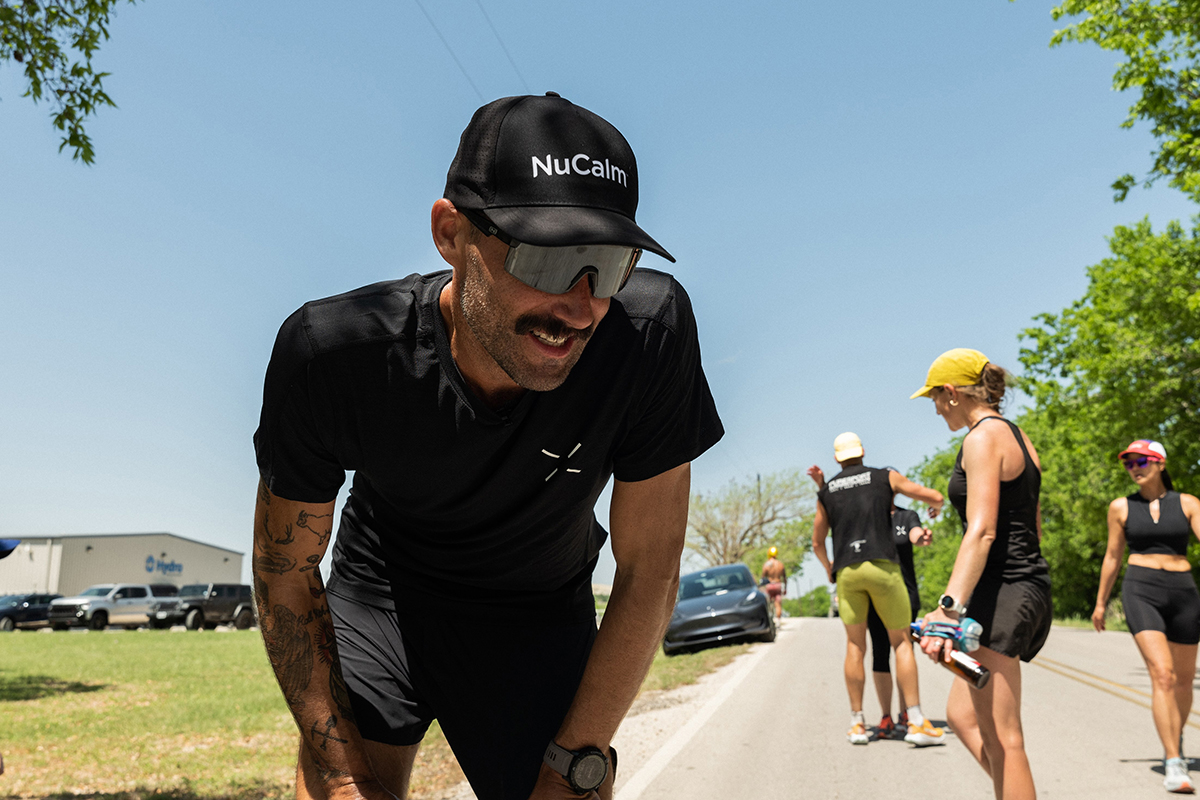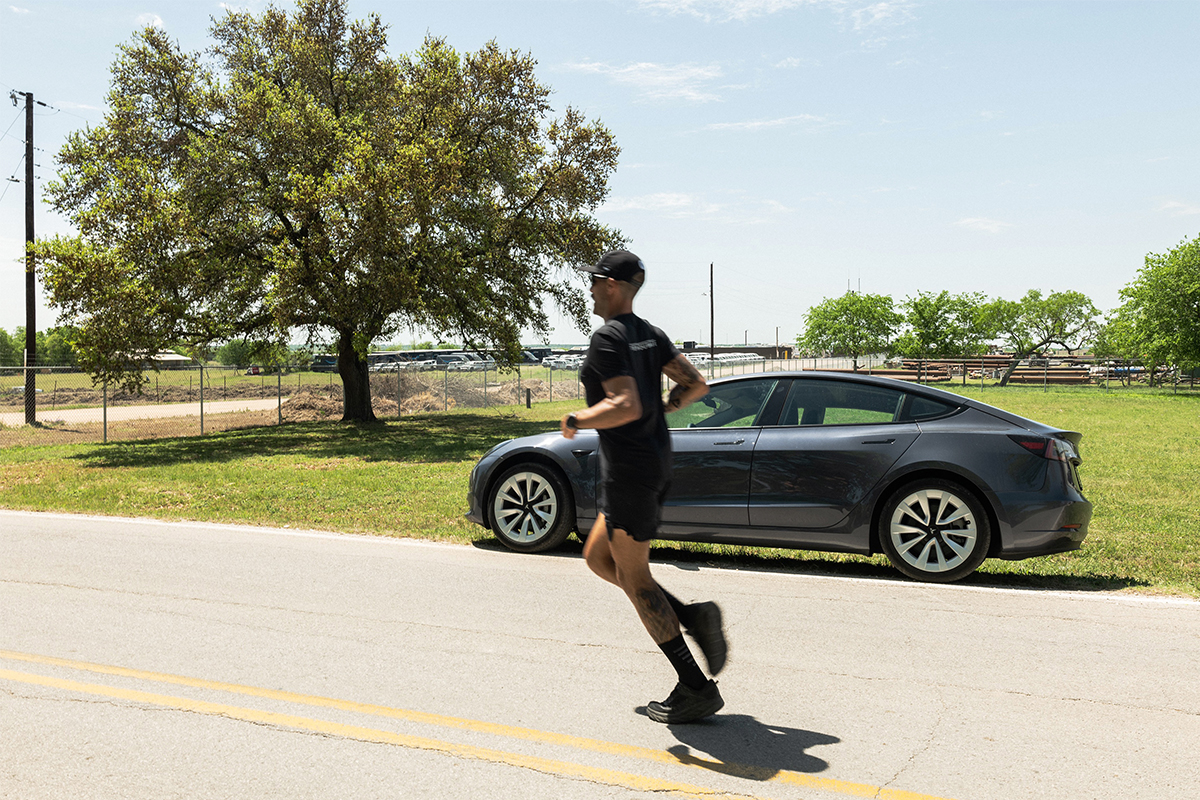The first official “Man versus Horse Marathon” took place some 42 years ago in the Welsh hamlet of Llanwrtyd Wells.
Naturally, the event was founded in order to settle a heated, nonsensical dispute between two patrons at the Neuadd Arms, a 19th century inn that sits on the side of the road in Britain’s smallest town. One man contended that a runner could defeat a rider on horseback, were both to cover a significant distance — say, 22 miles or so. The other disagreed. The owner of the bar, a man named Gordon Green, decided to put the debate to an actual test.
For those who must know: horse has defeated human in 38 of 40 races, and our species hasn’t brought home a win since 2007, when Florian Holzinger, a German triathlete, beat a horse named Lucy by 11 minutes. Decades later, it’s fair to say that each drinker had a point.
Walk into a bar in 2022, and you’re not likely to hear any locals arguing about whether an ultrarunner could outlast a fully-charged Tesla Model 3. Who in their right mind would attempt something so insane? Well, it isn’t just possible; it was accomplished last week, by endurance-athlete-extraordinaire Robbie Balenger.
The 37-year-old California native has pulled off some stunning efforts over the years — he’s run across the country in 75 days, he owns the world record for the most consecutive loops around Central Park, he once completed the infamous Colorado Crush — but the Tesla Challenge was Balenger at his most daring and creative.
Backed by New York-based Ten Thousand, as part of the brand’s ongoing “Feats of Strength” series, Balenger’s modern riff on the man vs. horse model involved three straight days of running, a battle with oppressive Texas heat, lonely miles in the middle of the night, gastrointestinal issues, zero hours of sleep and somehow, some way, a 100-foot victory over everyone’s favorite electric car, which officially conked out after 242 miles on a single battery.
How (why in god’s name) did he do it? Would he ever do something like this again? Should we start giving runners a little more credit in our barstool debates? Below: Balenger dishes on his biometric stats (31,000 calories burned in three days!), the role plant-based eating played in his effort and the moment when the challenge became “less a race against a Tesla and more a fight with Texas.”

InsideHook: Just so I’m clear — did you not sleep at all during this race?
Robbie Balenger: I had four hours and 50 minutes of downtime throughout the 77-hour effort, but yes, you’re correct. No sleep. When I desperately wanted to sleep and decided to take a break from running, I used NuCalm to maximize my rest. It’s this neuroscience tech that allows your brain to drop into Alpha and Theta waves. Basically, the parasympathetic nervous system take overs and helps optimize cellular recovery. Pretty wild, my crew never once had to “wake me up” during these sessions with NuCalm. I would lie down for an amount of time and listen to a specific NuCalm track. When it was over, my brain and body felt rejuvenated and I could began the process of getting back on the road.
At what point in the race did you know that the Tesla had officially stopped at 242 miles? Did knowing that number impact your pacing or thought process at all?
It was somewhere around five hours into the effort when we got word of the Tesla’s final distance. To be honest, it didn’t have much of an effect on me. I already knew this effort was going to be much longer than anything I had ever done before and a lot of my mental preparation involved imagining running forever. After the effort started, I had to quickly find a sustainable gear and stick to it in order to assure that I could go the long haul.
What was your average pace per mile? Was there any dramatic fluctuation (one way or the other) over the three days?
My average elapsed pace for the effort was 19:04 per mile. This pace includes all stops for food, restroom breaks, and my four hours and 50 minutes of downtime. On the whole my pace was very consistent. But like any ultra, there were many highs and lows. At times I was reduced to a walk and at others I was flying. At one point around 140 miles in, almost as a joke, I dropped to a sub-six minute mile pace. Mainly just to get a rise out of those running with me at the time.
What was the most physically challenging portion of the race?
The most challenging aspect of the race was the heat/humidity. We saw temperatures reach 93 degrees with very high humidity. Factor in the radiating heat from the asphalt and it had to be closer to 100 degrees on the road. This made the effort 10 times harder than it would have been at cooler temps. Due to the heat throughout the first day, my first night involved major GI issues. My stomach felt like it was seizing, making it almost impossible to eat or drink. This lasted throughout the night and we were all afraid we had gone down the slippery slope of dehydration and calorie deficiency. The next two days we paid a lot closer attention to cooling down my core temperature whenever possible, which allowed me to digest and hydrate much more easily.
What did you find most mentally challenging?
The longevity of the effort was daunting. Running for over three days meant that I didn’t see the light at the end of the tunnel until the last 20 miles. But even the last 20 miles felt long.
How many miles did you run alone?
I ran the very first 24 miles alone, which allowed me time to focus and get in the zone. After that, for both safety and morale reasons, I had pacers with me. I am very thankful and appreciative to everyone who joined me for those miles.
How did this race compare to other feats you’ve accomplished over the last few years?
I would say this was by far the most challenging yet. The sustained movement, so little downtime, and the heat made it all extremely challenging.
What sort of fuel did you rely on during the race? How often did you eat?
The goal was to eat no less than once an hour while hydrating in between. Food included plant-based options such as Plant-Strong’s cereal with oat milk, lots of fresh fruit, cold pasta with olive oil, gnocchi, whole-food based gels, and BPN Bare Bars. For hydration, I relied on Bare Performance Nutrition Electrolytes and their G.1.M. Sport, which also provided calories.
When did you turn plant-based? How has the switch impacted your energy/endurance (if at all)?
I turned completely plant-based about 6 months before taking on my Transcontinental Run in March of 2019. Choosing a plant-based diet increased my performance more than any other single factor in my running. Meat causes inflammation and inflammation causes soreness. Without soreness being a factor I am able to train and perform harder and more often. Also making these food choices allow me to sleep better at night knowing I am choosing foods that make the lowest impact on the environment.
What did your weekly training regimen look like, in preparation for this race?
Luckily due to years of training and big efforts I entered this training block with a pretty strong base. My training was focused on long runs. I ran over 20 miles a day, five to six days a week, for the two months leading up to the Tesla Challenge.
Can we have a peek at your biometric stats from the race?
- Mileage – 242.01
- Elevation Gain – 12,959ft
- Elapsed Time – 76:54:46
- Avg. Pace – 19:04
- Avg. Heart Rate – 110 bpm
- Best Mile – 9:09
- Calories Burned – 30,555
Why run this one in the Texas heat?
Well, I wasn’t expecting such brutal temperatures for this time of year in Central Texas. Though in true Texas fashion, that’s what it gave me. I chose Central Texas because it’s a place that holds a very special place in my heart. I lived in Austin for 10 years. My time there made for some of the most memorable years of my life, including meeting my wife. I still try to visit as often as I can. Part of my heart will always be in Texas. I often say, Texas is less of a place and more of a state of mind, with so many great storytellers and music legends. This effort quickly became less a race against a Tesla and more a fight with Texas.
Did you eat a big meal after the race? How long did you sleep?
My first meal after the race was at Bouldin Creek Cafe, and I ate all I could. Sleep has been hard since completing the effort. My circadian rhythm is all out of whack, and I’ve been dealing with some pains in my glutes that wake me up every few hours. I continue to utilize NuCalm and luckily those sessions post-Tesla Challenge have helped to keep me from slipping into deep exhaustion.
Do you have any other “pipe dream” race ideas for the future?
This fall I plan to take on the 3 Peaks Challenge in the UK. I will summit the tallest peaks in England, Wales, and Scotland, traversing the distance between the peaks all by foot. It will be about a 450-mile effort, which I hope to accomplish in less than 9 days.
The Charge will help you move better, think clearer and stay in the game longer. Subscribe to our wellness newsletter today.
























